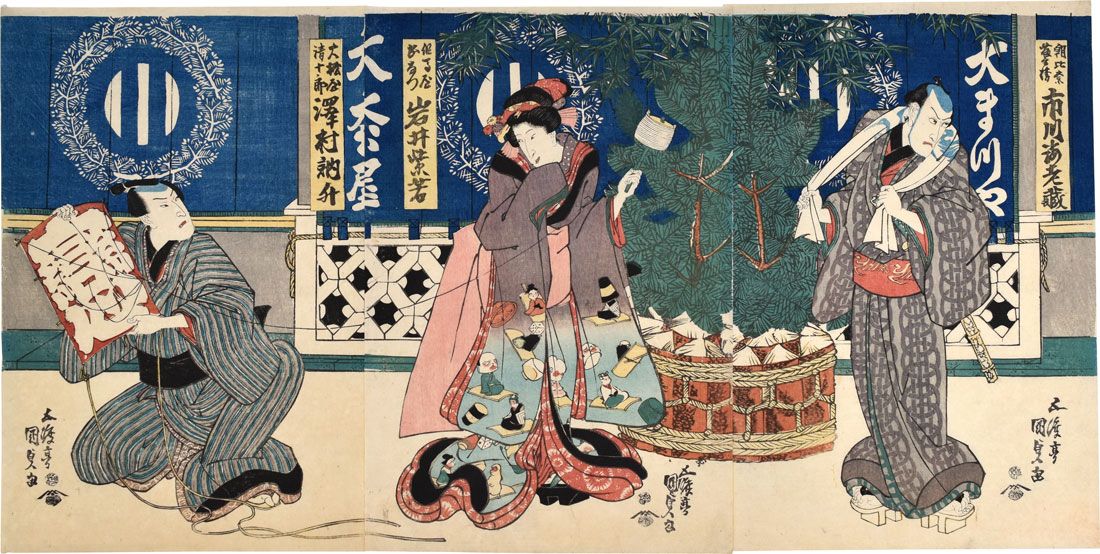| |
KUNISADA(Toyokuni-III)(1786 - 1864)'A Scene from the Revenge of the Soga Brothers'('New Year's Day Kite Flying') (descriptive titles) |

'A Scene from the Revenge of the Soga
Brothers'
(lit. 'Romantic Love between Wago and Soga')
(Koi Sumou Wagō Soga (Koizu Mō Yawaragi Soga), 戀相撲和合曽我 (こいずもうやわらぎ曽我))
1841
Kite flying is also a popular pastime for boys during the New Year celebrations. The left panel shows Sawamura Tossho (Suketakaya Takasuke III, 1802-1853) in the role of Omatsuya Seijuro with a small Edo kite, decorated with the kanji character "koi" (戀 or 恋) meaning 'romantic love'. 'Koi' is also the first character of the title of the play. Iwai Shijaku-I (Hanshiro VII, 1804-1845) in the female role of Tajimaya Onatsu in the center panel holds the the kite's spool and string. The big threefold repeated white on blue logo at the stage background, may be the emblem of the Kawarazaki Theatre.
The Soga Monogatari is one of the most popular stories in Japan. There are many variations of this popular kabuki script. Almost every well-known woodcut artist of his time made kabuki woodcuts with the soga monogatari theme. Kunisada even made various woodcuts with this subject. Various representations within this theme with depicted kites may also be found (cp. 1, 2 and 3).
Series - ~
Artist - see Biography
Signature -"Gototei Kunisada-ga" ("五渡亭国貞画") on all three panels; censor's seal (改印) kiwame (極)
Publisher - Tsutaya Kichizo (蔦屋吉蔵), Koeido printshop (紅英堂)
Image Size - 37.8 X 76.3 cm (14 7/8" x 30") + margins as shown
Condition - triptych, three single panels; nishiki-e (cloured woodblock); Vertical ôban (ôban tate-e);
(lit. 'Romantic Love between Wago and Soga')
(Koi Sumou Wagō Soga (Koizu Mō Yawaragi Soga), 戀相撲和合曽我 (こいずもうやわらぎ曽我))
1841
Comment - Kabuki scene from a New
Years screenplay 'Koi Zumo Yawaragi Soga'
(恋相撲和合曽我(こいずもうやわらぎ曽我) which was staged at the Kawarazaki
Theatre (河原崎) in the first lunar month of 1841. The plot is a
variation of the multi favoured "Tale of the Soga
Brothers" ("Soga monogatari", "曽我物語"). Plays related to
the revenge story of the Soga Brothers were traditionally
produced at the time of the New Year. The prominent pine
decoration or kadomatsu
on the right and center panel of the woodblock print gives
this impression.
There were numerous variations on the Soga
Monogatari theme, but certain characters were expected to take
part. In this version, which appears to have been staged only
this one time in 1841, the above depicted kabuki performance
shows Ichikawa Ebizo-V (Ichikawa Ebizō-go-daime, 市川海老蔵-五代目)
aka Danjuro-VII (1791-1859) as Asahina Tobei (朝比奈藤兵衛).
Asahina is variously Soga no Goro's friend and a friend of the
villain, Lord Kudo.Iwai Shijaku-I (Iwai Shijaku-shodai,
岩井紫若-初代) aka Hanshiro-VII (1804-1845) performes the female
character Tajimaya Onatsu (Tajima-ya o natsu, 但馬屋お夏). Sawamura
Tossho-I (Sawamura totsushō-shodai, 沢村訥升--初代), aka Suketakaya
Takasuke-III (1802-1853) plays Omatsuya Seijuro (Ōmatsuya
Seijūrō, 清十郎 大松家). Name and role of the adjacent actor can be
found in the respective yellowish cassette.
Kite flying is also a popular pastime for boys during the New Year celebrations. The left panel shows Sawamura Tossho (Suketakaya Takasuke III, 1802-1853) in the role of Omatsuya Seijuro with a small Edo kite, decorated with the kanji character "koi" (戀 or 恋) meaning 'romantic love'. 'Koi' is also the first character of the title of the play. Iwai Shijaku-I (Hanshiro VII, 1804-1845) in the female role of Tajimaya Onatsu in the center panel holds the the kite's spool and string. The big threefold repeated white on blue logo at the stage background, may be the emblem of the Kawarazaki Theatre.
The Soga Monogatari is one of the most popular stories in Japan. There are many variations of this popular kabuki script. Almost every well-known woodcut artist of his time made kabuki woodcuts with the soga monogatari theme. Kunisada even made various woodcuts with this subject. Various representations within this theme with depicted kites may also be found (cp. 1, 2 and 3).
Series - ~
Artist - see Biography
Signature -"Gototei Kunisada-ga" ("五渡亭国貞画") on all three panels; censor's seal (改印) kiwame (極)
Publisher - Tsutaya Kichizo (蔦屋吉蔵), Koeido printshop (紅英堂)
Image Size - 37.8 X 76.3 cm (14 7/8" x 30") + margins as shown
Condition - triptych, three single panels; nishiki-e (cloured woodblock); Vertical ôban (ôban tate-e);
Copyright 2008 ff: Hans P. Boehme